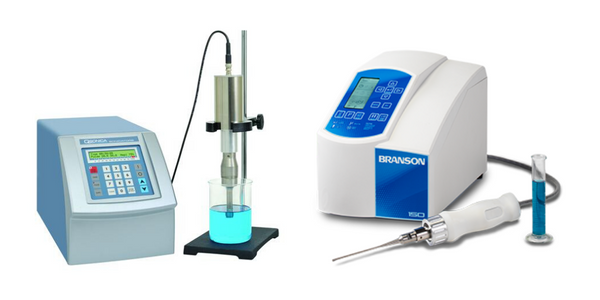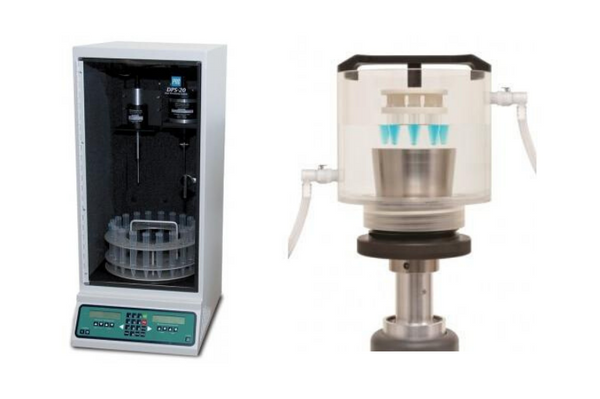Both rotor stator homogenizers and ultrasonic homogenizers may be suitable for certain applications, leaving you with a decision to make. In most situations, one will be preferable over the other, with the right choice depending on various factors of your application.
In this article, we examine each technology along with its pros and cons, to help you make an informed decision. We’ll also include a feature summary and a list of common applications for each type of homogenization.
Rotor-Stator Homogenizers
A rotor-stator homogenizer works by using rotary mechanical force to process a sample. A metal shaft (called a rotor) rotates rapidly within a metal casing (called a stator). The resulting suction effect draws the sample between the two components and subjects it to high-shear forces.

Left to right: A D1000 Handheld Homogenizer,a D500 Homogenizer, and a PRO400 Benchtop Homogenizer.
Pros of Rotor-Stator Homogenizers
- For single-sample applications, these homogenizers are quick and efficient.
- They can be used for liquid samples or solid / liquid suspensions.
- Since you can switch out probes, with some models, you have a large sample size range to work with. For example, one unit might be capable of processing both a 30 microliter or 30 liter sample.
- Some in-line production models have no volume limit. This means you can scale up processes as needed.
- You have the option to use special probes for specific applications. For example, for more fibrous samples, a saw-tooth probe would be suitable.
Cons of Rotor-Stator Homogenizers
- While they’re good for single-sample applications, this can be limiting. There are units which can process multiple samples at once, but these can be expensive.
- If you do use a rotor-stator for multiple samples, and cross-contamination is a concern, you’ll need to wash probes between uses, so processing can become labor-intensive and time-consuming.
- Solid samples aren’t compatible with a rotor-stator homogenizer.
- For hard or fibrous samples, you may need to do some pre-processing.
Ultrasonic Homogenizers
Ultrasonic homogenizers (often called “sonicators”) have a probe (horn) that vibrates. When the probe is inserted into the sample, these extremely rapid vibrations blast nearby particles with massive amounts of energy. This energy causes the formation and collapse of bubbles, a phenomenon known as cavitation. In turn, the collapse of bubbles sends shock waves through the sample and creates shear forces.

Left to right: A Q500 Sonicator and a Sonifier® SFX150.
Pros of Ultrasonic Homogenizers
- Ultrasonic homogenizers are very powerful pieces of equipment capable of imparting a large amount of energy over a relatively small area.
- They can be used to drastically decrease particle size in a short amount of time.
- Extremely small particle sizes can be obtained.
- Probes consist of a single component, meaning they are easy to clean.
- You have a decent range of sample size options to work with for a given unit as you can switch between probes.
- Ultrasonic homogenizers are suitable for liquid samples.
- They are very quick and efficient for processing single samples.
Cons of Ultrasonic Homogenizers
- Ultrasonic homogenizers can produce lots of heat. As such, alternative equipment should be considered for heat-sensitive applications.
- Titanium probes are used which may mean that trace amounts of titanium end up in your sample. This could be a concern for some applications.
- These homogenizers aren’t really suitable for plant-scale applications.
- With heavy use, horns may need to be replaced frequently.
- These units can be quite noisy, so it’s important to consider their location carefully.
- Ultrasonic homogenizers aren’t suitable for high-viscosity or solid samples.
Summary of Rotor-Stator Homogenizers Versus Ultrasonic Homogenizers
The choice between a rotor-stator homogenizer and an ultrasonic homogenizer can be a tough one, especially if you have both at your disposal. Both pieces of equipment are suitable for use with single, liquid samples. They both offer a broad range of sample sizes, although you’ll usually find a larger range for a rotor-stator unit than an ultrasonic homogenizer.
In general, a rotor stator homogenizer is better for larger scale applications, particularly if you need to scale up to production batches later. If you’re comparing the two side-by-side based on sample size, a rotor-stator homogenizer is usually less expensive. It’s also the preferred option if you’re worried about traces of titanium in your sample or heat generation.
That said, ultrasonic homogenizers have their advantages over rotor stator homogenizers, the main one being that they can produce smaller particle sizes. If you’re looking for the most efficient technology in terms of the shortest processing time, an ultrasonic homogenizer will usually win out against a rotor stator homogenizer. While both technologies can process relatively small samples when the right setup is used, an ultrasonic homogenizer can process extremely small sample sizes through the use of a cup horn..
With either piece of equipment, if you need to process multiple samples quickly, you’ll have to deal with cleaning the probe between each run. This is especially labor-intensive if you’re worried about contamination and have to thoroughly clean each time. If deciding between the two, this would be simpler with an ultrasonic homogenizer as its probe consists of just one component.
If you’re looking for high throughput, there are some suitable units. In fact, there’s the DPS-20 Homogenizing System which incorporates both ultrasonic and rotor stator homogenization. This is a fairly expensive option though. There are also some ultrasonic homogenizers that are compatible with cup horns. These apply ultrasonic energy to samples without coming into contact with them, preventing cross-contamination and allowing processing of extremely small sample sizes. However, the intensity is relatively low and they only work for small samples.

The DPS-20 Homogenizing System and a Cup Horn for the Q500 & Q700 Sonicators.
The table below shows a summary of the main features of these two technologies:
|
Rotor Stator Homogenizer |
Ultrasonic Homogenizer |
|
|
Particle Size |
Min particle size: ~2–3 µm |
Min particle size: <100 nm |
|
Sample Size |
0.03 mL and up |
10 μL – 20 L |
|
Max. Viscosity |
~ 10,000 cP |
~ 4,000 cP |
|
Throughput |
Generally low |
Generally low |
|
Scaleup |
Easy to scale up |
Suitable for some scaleup |
|
Heat Generated |
Some heat generated |
A lot of heat generated |
|
Ease of Use |
Easy to set up and good for single samples |
Easy to set up and good for single samples |
|
Cleaning |
Running in a solvent will often suffice between uses, but more thorough cleaning requires disassembly of the probe. |
Very simple to clean between uses – only the probe requires surface cleaning |
While it can be tough to decide between these two technologies, the nature of your application will typically signal which is the best option for you. Here are some common applications for rotor-stator homogenization and ultrasonic homogenization:
|
Rotor-Stator Homogenizer |
Bead Mill Homogenizer |
|
Emulsification Suspensions General particle size reduction (> 1 µm) Cell lysis Tissue homogenization Cell isolation |
Nanoparticle creation Emulsification Particle size reduction Cell lysis Tissue homogenization |
